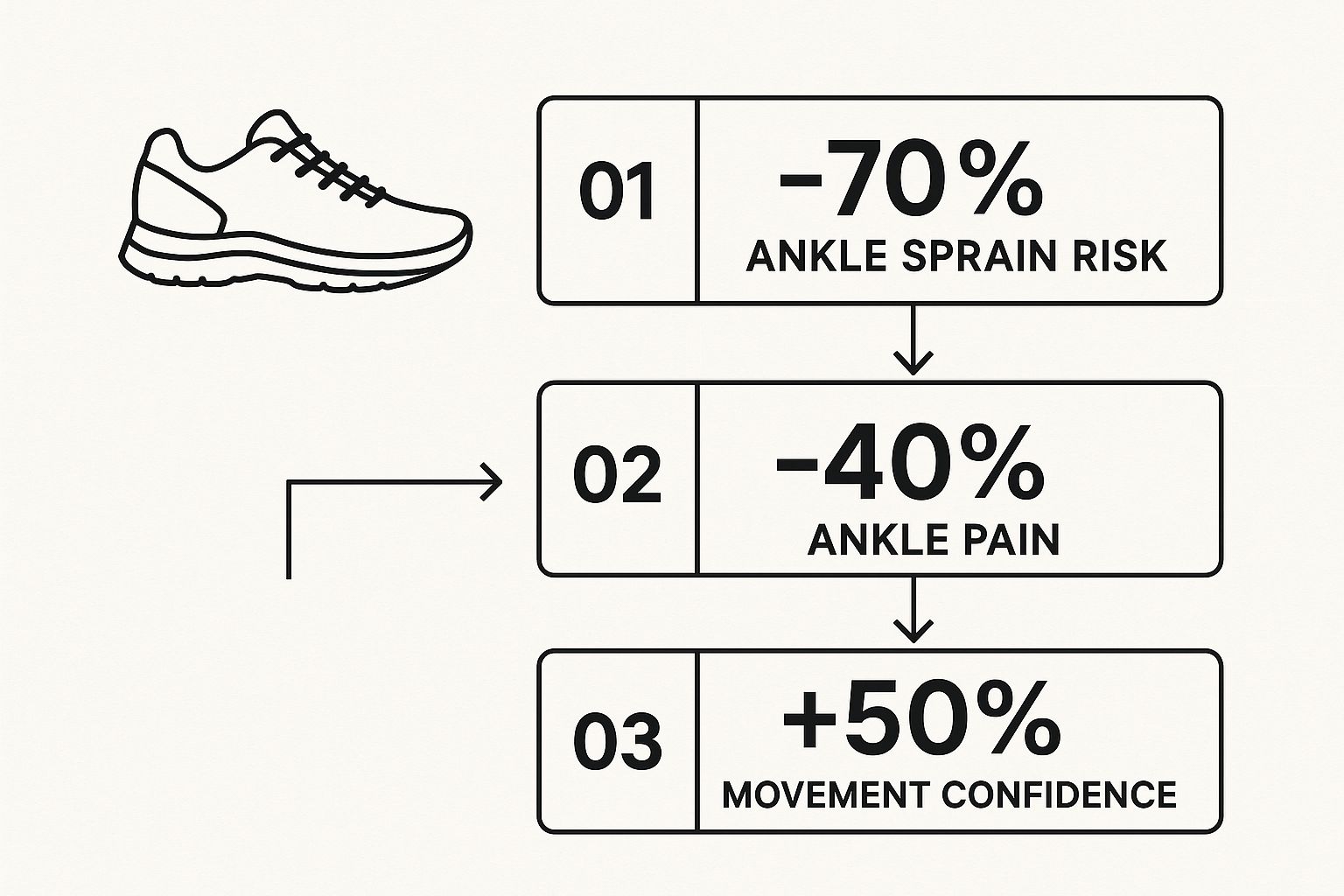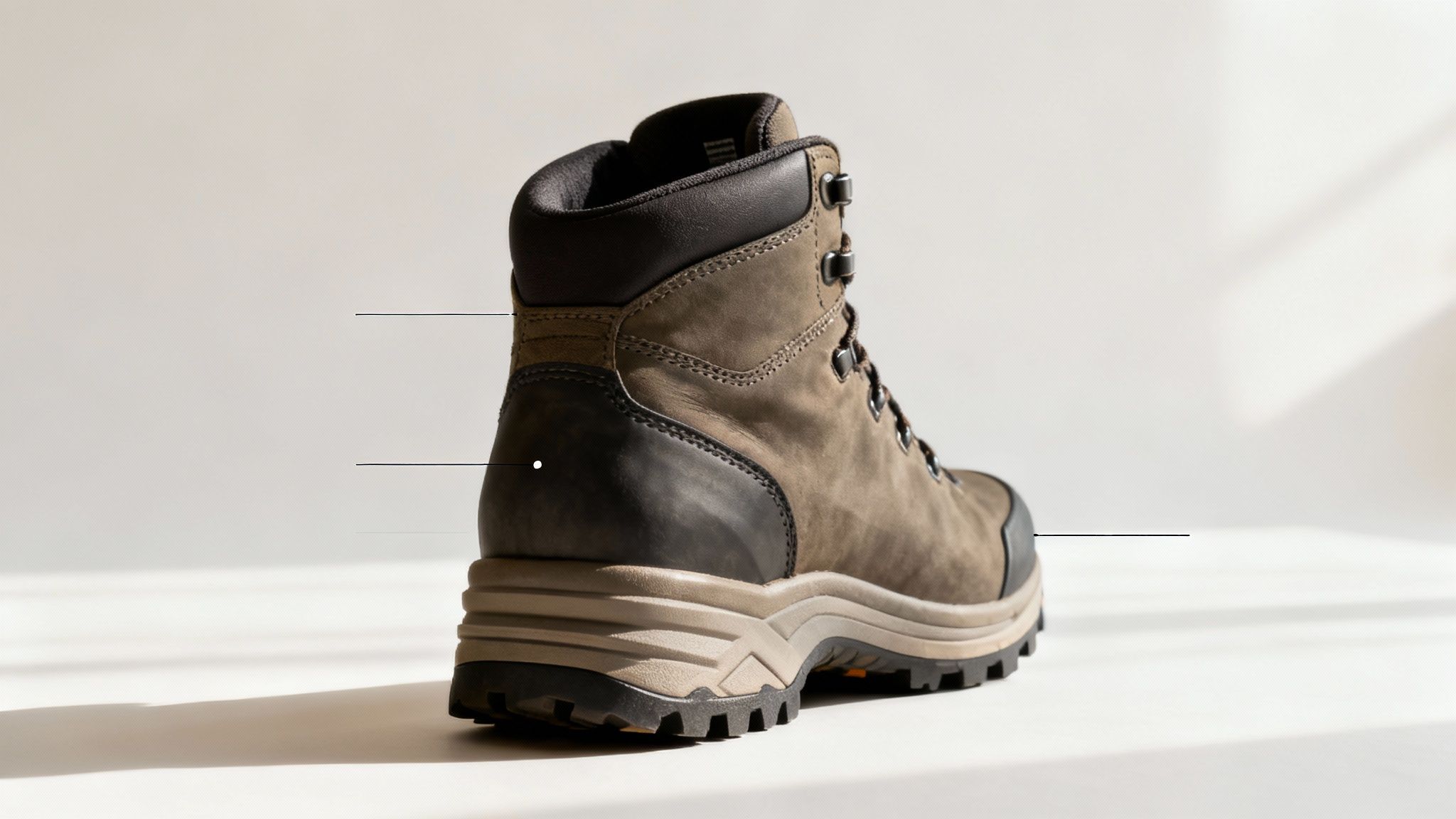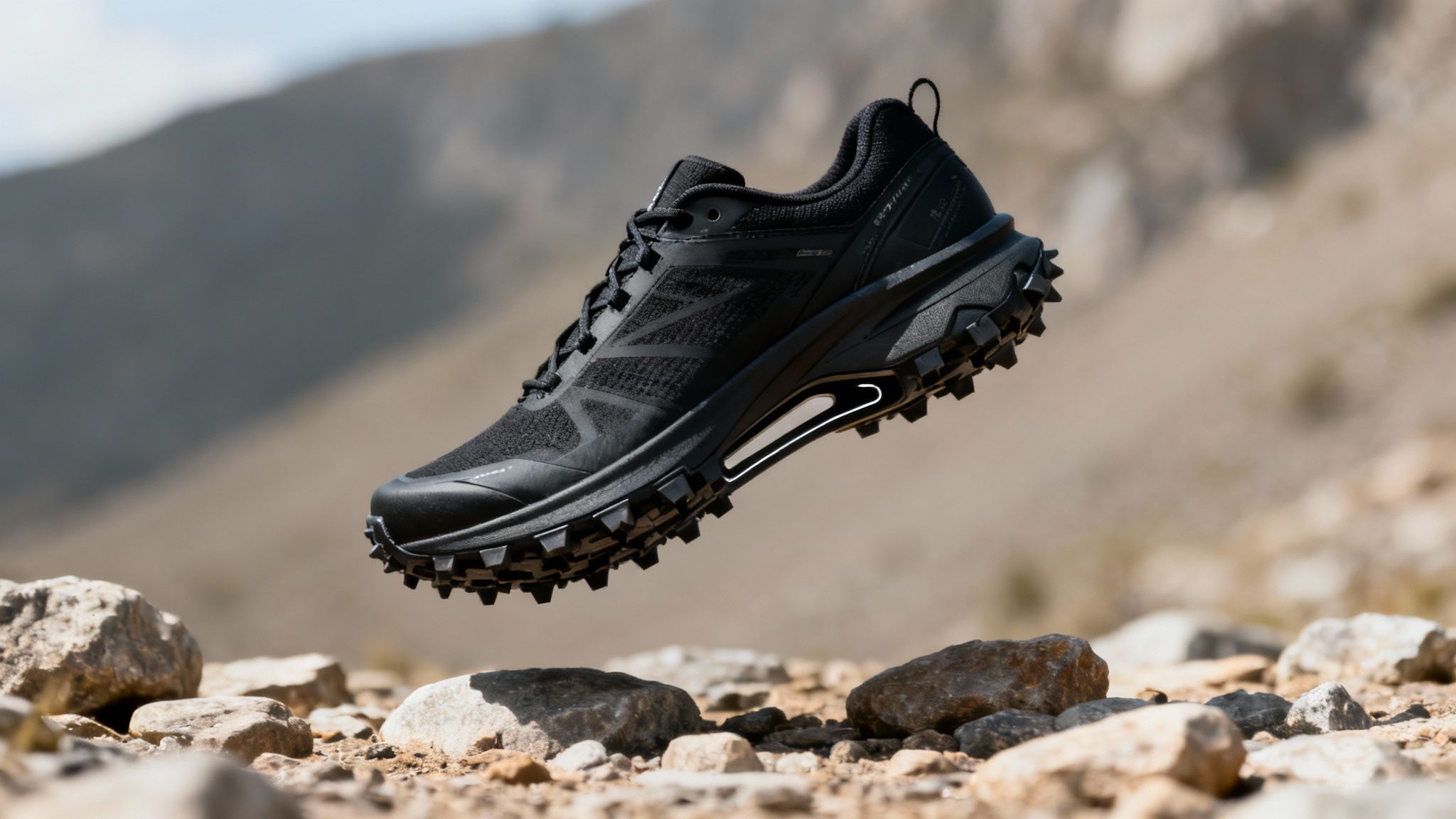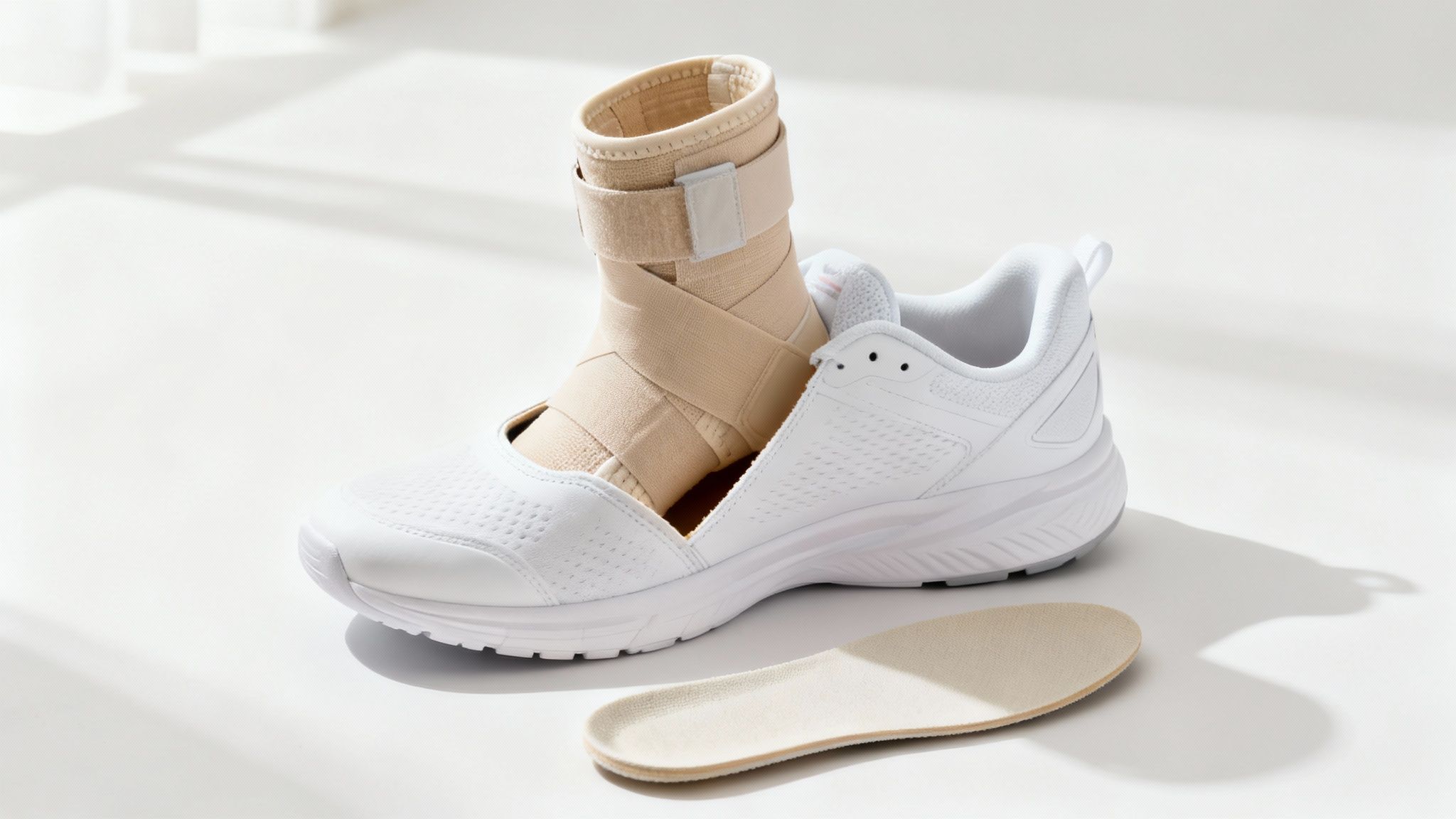Finding the Best Shoes for Ankle Support: Hiking, Court, and Running
- Flourish Everyday Health And Fitness

- Oct 12
- 8 min read
Updated: Oct 15
Finding the right shoes for ankle support is a game changer for preventing injuries and feeling more stable, especially if you have weaker ankles or engage in high impact activities. Key features like a firm heel counter, a supportive midsole, and a snug fit can make a world of difference in your daily comfort and joint health. This guide will cover everything you need to know to make an informed choice.
Table of Contents:
Why Ankle Support in Your Shoes is Essential
We often ignore our ankles until a sudden twist or a nagging ache reminds us of their importance. Proper footwear isn't just about comfort, it's a critical tool for preventing injuries, managing chronic issues, and moving with confidence. A 2021 study highlighted that appropriate footwear significantly reduces the risk of ankle sprains, which are among the most common musculoskeletal injuries (Haddad et al., 2021).
Think of proper shoes for ankle support as the foundation for your body. They stabilize every step, which is vital whether you're recovering from an injury, hiking a rocky trail, or just need more security in your daily routine.
The Real-World Impact of Supportive Footwear
The benefits go beyond comfort. For runners, good footwear is a key part of safe training, as discussed in our guide on how to prevent running injuries. For those on their feet all day, it means less fatigue and a lower risk of chronic pain.
This infographic breaks down how the right footwear can impact your safety.

Investing in supportive shoes can significantly reduce your chance of a painful sprain and boost your confidence with every step, allowing you to maintain an active lifestyle proactively.
Choosing shoes with dedicated ankle support is one of the most effective, non-invasive ways to protect your joints. It's a daily habit that pays long-term dividends for your mobility and overall health.
Understanding the Ankle's Role
The ankle is a complex structure of bones, ligaments, and tendons supporting your entire body weight. Its stability is the first link in the chain for proper alignment up through your knees, hips, and back. When shoes lack support, the ankle works overtime, leading to strain and injury. Good ankle support maintains crucial alignment, ensuring your body moves as it should.
Benefit | Impact on Your Well-being |
|---|---|
Injury Prevention | Significantly lowers the risk of sprains and strains by stabilizing the ankle joint. |
Improved Stability | Provides a solid base for better balance on uneven or slippery surfaces. |
Pain Reduction | Alleviates discomfort from conditions like plantar fasciitis and chronic ankle instability. |
Enhanced Performance | Allows for more confident and efficient movement during sports and daily activities. |
Better Body Alignment | Promotes proper posture, reducing stress on your knees, hips, and back. |
Ultimately, the right footwear acts as a protective layer, giving you the freedom to move confidently and comfortably.
What to Look for in a Supportive Shoe
Navigating a shoe store can be overwhelming, with every brand claiming superior support. The key is to ignore marketing hype and assess a shoe's construction. Once you know what to look for, you can find excellent shoes for ankle support from nearly any brand.

Look past style to the shoe's structural integrity. A flimsy fashion sneaker won't provide the support needed to prevent injury and ensure comfort.
The Foundation of Support: The Heel Counter
The heel counter, a rigid insert cupping your heel, is your primary defense against your foot rolling. To test it, pinch the heel of the shoe. If it collapses easily, it lacks support. A supportive shoe will have a firm heel counter that locks your heel in place for maximum stability.
Midsole and Shank: The Core Structure
The midsole and shank provide the shoe's core stability under your arch. A supportive midsole should feel firm, not mushy, preventing your foot from collapsing inward or outward. The shank, a stiff piece within the midsole, prevents the shoe from twisting.
Test twisting rigidity by grabbing the shoe by the heel and toe and trying to wring it like a towel. A shoe with a good shank will resist twisting, ensuring stability on uneven ground. This principle is vital, whether on a trail or finding good shoes for squats and deadlifts.
Another test: try to bend the shoe in half. A well-built shoe should only flex at the ball of the foot. If it folds in the arch, it lacks essential midfoot support.
Upper Construction and Fit
The upper materials and overall fit are also crucial. The key is lockdown, a lacing system that secures your entire foot. A wide toe box is also essential, allowing your toes to spread naturally for better balance. Ensure there's a thumb's width of space between your longest toe and the shoe's end.
Top Athletic Shoes for Ankle Stability
During intense physical activity, your ankles bear the brunt of the impact. The support needed for basketball differs from that required for trail hiking, making activity specific footwear non-negotiable for performance and injury prevention.

The athletic footwear market is a massive industry because athletes understand that preventing injuries is paramount. Ankle injuries account for a significant portion of all sports-related injuries, placing robust support at the top of designers' priorities. You can review the full athletic footwear market research.
Men's Top Picks
Best for Hiking: Salomon XA Pro 3D V8 - This trail shoe features a 3D Advanced Chassis™ that acts as a stabilizing frame, minimizing side-to-side flex and protecting your ankle on uneven terrain.
Best for Basketball: Nike LeBron 21 - Engineered for power and stability, this shoe has a beefy heel counter, external TPU wings, and a secure lacing system to handle aggressive cuts and landings.
Best for Running: Brooks Adrenaline GTS 23 - Known for its GuideRails® support system, this shoe helps control excess movement, making it a stable choice for runners who overpronate.
Women's Top Picks
Best for Hiking: Merrell Moab 3 - Often called the "mother-of-all-boots," it delivers serious support with a solid heel counter and a nylon arch shank for rigidity on tough trails.
Best for Court Sports: Asics Gel-Rocket 11 - This shoe offers excellent stability for sports like volleyball and pickleball with a TRUSSTIC™ system in the midsole that prevents twisting.
Best for Running: Hoka Arahi 7 - Featuring Hoka's J-Frame™ technology, this shoe provides stability without adding stiffness, guiding the foot naturally for a smooth ride.
While most running shoes are built for forward motion, some models offer stability suitable for cross-training. Our review of the Brooks Adrenaline GTS 23 for CrossFit training offers more insight.
Best Overall Shoe Brands for Ankle Support
While specific models excel for certain activities, some brands consistently prioritize stability and support across their entire product lines.
Brooks: Renowned for their GuideRails® technology, Brooks running shoes are a top choice for those needing motion control and reliable support.
New Balance: This brand offers many models in multiple widths, ensuring a proper fit, which is the foundation of good support. Their shoes often feature firm heel counters and well-structured midsoles.
ASICS: With technologies like the TRUSSTIC SYSTEM™ and GEL™ cushioning, ASICS provides a blend of stability and comfort, especially for court sports and running.
What to Do When Regular Shoes Aren't Enough
Sometimes, even supportive sneakers don't provide the needed relief for chronic issues like plantar fasciitis or severe arthritis. In these cases, orthopedic and therapeutic footwear may be necessary. These are medical grade devices engineered to improve mobility and quality of life by providing targeted relief for biomechanical problems.
What Makes Orthopedic Shoes So Different?
Therapeutic footwear is designed with features to accommodate and correct foot problems, offering a personalized support system.
Extra-Depth Construction: Provides room for custom orthotics or braces.
Customizable Insoles: Removable, multi-layered insoles allow for tailored arch support.
Rock-Solid Shank: A stiff shank prevents twisting, offering crucial midfoot stability.
The demand for these shoes is rising, with the global orthopedic shoe market valued at around USD 3.48 billion. This growth is driven by increased awareness of foot health and a rise in conditions like diabetes and arthritis. You can explore these market trends on Market Research Future.
Who Really Needs This Level of Support?
Orthopedic footwear can significantly benefit individuals dealing with particular health issues.
Diabetes: Shoes with a seamless interior and roomy toe box are crucial for preventing sores that can lead to infection.
Arthritis: Rocker soles and heavy cushioning can absorb painful impact on joints.
Post-Surgery Recovery: The stability and accommodating fit protect the healing area.
Combining Braces with Supportive Shoes
For severe injuries or chronic instability, pairing footwear with an ankle brace can provide maximum protection and confidence. The key is ensuring the shoe and brace work together as an integrated unit.

A proper fit is crucial. A shoe must have enough interior volume to accommodate a brace without creating painful pressure points.
Ankle Braces vs. Supportive Shoes: A Comparison
While both aim to stabilize the ankle, they function differently. Supportive shoes provide a stable base and control motion, while braces offer direct mechanical restraint to prevent excessive movement.
Feature | Supportive Shoes | Ankle Braces |
|---|---|---|
Primary Function | Provide a stable foundation, guide the foot, and cushion impact. | Mechanically restrict excessive ankle motion (e.g., inversion). |
Best For | General instability, mild pronation, injury prevention in low-risk activities. | Acute injury recovery, chronic instability, high-risk sports. |
Comfort | Designed for all-day wear. | Can be bulky and may restrict natural movement; not for continuous wear. |
Mechanism | Firm heel counter, rigid shank, supportive midsole. | Stays, straps, hinges, and compression fabrics. |
A 2015 meta-analysis found that ankle braces are highly effective in preventing recurring ankle sprains, especially in athletes with a history of injury (Verhagen & Bayrakci, 2015). However, for daily preventative care, a well-constructed supportive shoe is often the best first line of defense.
The market for foot and ankle braces, valued at around USD 4.65 billion, reflects their importance in recovery and prevention. You can find more data on the growth of the ankle braces market.
A Few Final Questions on Ankle Support Shoes
Let's address some common questions to ensure you're confident in your choice.
How Long Does It Really Take to Break in New Supportive Shoes?
A break-in period should not be painful. Most athletic shoes feel comfortable after 5-10 hours of light activity. Heavy-duty hiking boots or orthopedic shoes may need a week of wearing them around the house for an hour or two daily. If a shoe causes sharp pain out of the box, it's the wrong fit.
Can I Just Put an Ankle Support Insert in My Regular Shoes?
An orthopedic insert can improve arch support but cannot fix a flimsy shoe. True ankle stability comes from the shoe's structure: a firm heel counter, a rigid shank, and a supportive midsole. An insert works best when it enhances an already supportive shoe.
How Do I Know When It’s Time to Replace My Ankle Support Shoes?
Visible wear is an obvious sign, but loss of support often happens first. Check for uneven tread wear on the outsole. Squeeze the midsole; if it feels mushy, the support is gone. Place the shoes on a flat table and view them from behind. If they lean to one side, their structural integrity is compromised. For athletic shoes, a general rule is to replace them every 300-500 miles.
References
Haddad, M., et al. (2021). Footwear and Ankle Sprain. Journal of Foot and Ankle Research.
Verhagen, E., & Bayrakci, V. (2015). Effectiveness of ankle braces in preventing recurrent ankle sprains. British Journal of Sports Medicine.
At Flourish-Everyday, we believe the right footwear is the foundation of a healthy, active lifestyle. Explore our expert reviews and guides to find the perfect shoes to support your every move. Visit us at https://www.flourish-everyday.com to continue your journey.


Comments